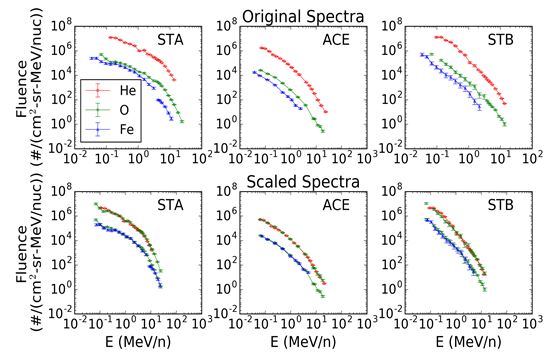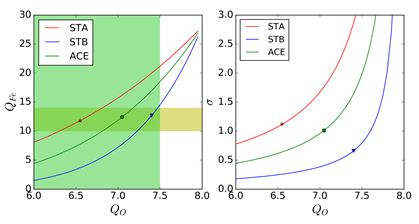Probing Shock Geometry via the Q/A Dependence of Heavy Ion Spectra at Multiple Spacecraft
PDF version
In large gradual solar energetic particle (SEP) events, the energy spectra of heavy ions often show double power laws with "break" energies that scale by the charge-to-mass (Q/A) ratio. The Q/A dependence of the scaling is organized by the diffusion coefficients and varies from event to event. In Li et al. (ApJ, 2009), the Q/A dependence of the scaling is related to the shock geometry when the CME-driven shock is close to the Sun. Thus, shock geometry can be probed remotely by examining the Q/A dependence of the break energies. We study the 2013 November 4 SEP event observed by STEREO-A (STA), STEREO-B (STB), and ACE because the time-integrated heavy-ion spectra from all three spacecraft show spectral break features above ~1 MeV/nuc (see Figure 1).

| Figure 1: The original He, O, and Fe spectra (upper panel) have been shifted both horizontally and vertically in the lower panel so as to ease their comparison and illustrate their common shape. |

| Figure 2: Left panel: Charge state of Fe vs. that of O in the 11/4/13 event. He is assumed to have Q=2. Shaded areas represent the most probable O and Fe charge states. Right panel: the scaling parameter σ vs. Q of oxygen. |
We studied the Q/A dependence of the energy scaling for heavy ion spectra using He, O, and Fe ions. Our analyses show that: 1) The He, O, and Fe spectra are well organized by Q/A at all 3 locations and when scaled by (Q/A)σ, spectra of both species overlay nicely; 2) the scaling parameter σ is sensitive to Q/A, and for the chosen heavy-ion charge states, we find σ for STA, ACE, and STB to be 1.12, 1.01, and 0.66, respectively (Figure 2); 3) in the framework of Li et al. (2009) these σ values suggest that STA and ACE are connected to the quasi-parallel portion of the shock and STB is connected to the quasi-perpendicular portion. Our analyses may be used not only to obtain shock geometry estimates for multiple spacecraft, but also to examine charge-state variability of heavy ions in an event. In principle, one can compare our Q/A estimates with direct measurements. For further details, see Zhao et al. (2016)
This item was contributed by L. Zhao of the Florida Institute of Technology, G. Li (gang.li@uah.edu) of the University of Alabama in Huntsville, G. M. Mason of Johns Hopkins University Applied Physics Laboratory, C. M. S. Cohen and R. A. Mewaldt of Caltech, and M. I. Desai, R. W. Ebert, and M. Dayeh of the Southwest Research Institute. Address questions and comments to
ACE News Archives
Subscribe to ACE News
ACE Homepage
Last modified 06 December 2016.